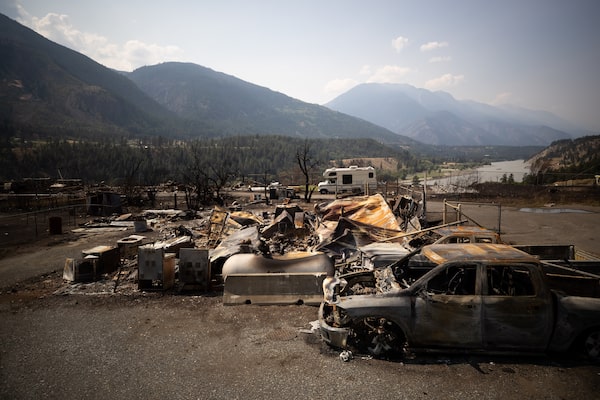
Damaged vehicles and a structure is seen in Lytton, B.C., on July 9, 2021, after a wildfire destroyed most of the village on June 30.DARRYL DYCK/The Canadian Press
Emergency supports for evacuees from the village of Lytton are drying up because remediation efforts have proceeded at a glacial pace.
On Tuesday, the B.C. government introduced legislation to address the stalled restoration efforts in Lytton, which was destroyed by wildfire more than seven months ago.
The proposed law underscores how much more work is still ahead.
Josie Osborne, Minister of Municipal Affairs, introduced a bill that would allow the village council to start to recreate bylaws that were destroyed in last June’s catastrophic fire. All of the village’s records and backup servers were lost during the fire, leaving a grey area for land-use regulation for building and zoning purposes and the risk of lawsuits if the village makes decisions without valid bylaws.
“Our government is listening to the needs of the village of Lytton,” she told the legislature Tuesday.
In addition, the province has promised an immediate transfer to the village of a little more than $6-million to help fix its water and waste water system, and to pay for requirements such as debris removal.
On June 30, a spreading wildfire raced through Lytton, home to 250 residents, and forced evacuations on nearby Lytton First Nation territory. Two residents died.
The wildfire followed an intense heat wave that led to temperatures in Lytton of nearly 50 C – the hottest weather recorded in the country’s history – shattered records across Western Canada and contributed to hundreds of deaths in B.C.
Lytton evacuees Peter and Matilda Brown, who have been temporarily housed in Kamloops, still haven’t been able to determine if the land where their home was is safe to rebuild on. But their temporary living allowance from their home insurance provider was cut off this month, because they haven’t met a deadline to hire a contractor to rebuild.
Ms. Brown, who is from the Ts’kw’aylaxw First Nation near Lillooet, noted that political leaders at the provincial and federal level have talked about Lytton as an example of the need for action on climate change, but the residents have been left on their own. “It’s not our fault that it’s taken this long,” she said.
She and her husband, an elder with the Lytton First Nation, lost precious family heirlooms – family baskets, drums, masks and paddles – and more when their home was destroyed in the fire.
They have found rental lodging and Ms. Brown commutes to her job in Lillooet. “The insurance company has been pressuring me to get building on this site but we don’t know what can be built on this site,” Mr. Brown said.
The province has raised concerns about contaminated soil but he has been left to sort out the testing himself. “We don’t know what’s going to be left in the ground, whether or not it’s going to be completely cleaned up or not.”
The Browns’ main concern, however, is about the community. The delays have left families and friends scattered, and children without their homes. “To me, there seems a complete lack of compassion from our government,” Mr. Brown said. “It’s been too long for them to not have a home.”
The Browns are not alone.
In January, the Insurance Bureau of Canada warned that additional living-expense supports being provided by insurers to their insureds affected by the Lytton fire would soon expire.
The insurance organization also said the delays in cleanup at Lytton are significantly driving up costs. It expects to pay out $102-million in insured damage, a figure that is $24-million higher than initial estimates. The industry has been calling for faster response from governments, noting that in other communities similarly devastated by wildfire, such as Fort McMurray, Alta., in 2016, most of the debris had been removed within six months and reconstruction was under way.
Mike Farnworth, the minister responsible for Emergency Management BC, said in a statement that the Canadian Red Cross can offer assistance until the end of May, and encouraged evacuees to reach out to the agency.
He also urged private insurance companies to be more accommodating. “I call on companies to offer flexibility and compassion to people in these exceptional circumstances.”
Ms. Osborne, the Minister of Municipal Affairs, told reporters that she understands the impatience of families who want to get on with rebuilding, but she would not say how long it will take to start reconstruction.
“It’s a unique situation,” she said. “We’ve had difficulty in getting access to the site, of course, and it’s a very important archaeological site as well.
“It’s really important that we do that safely, and we ensure that environmental contaminants are taken care of as people get in to remove the debris and to begin that really important process of recovery and rebuilding their lives in their homes.”
We have a weekly Western Canada newsletter written by our B.C. and Alberta bureau chiefs, providing a comprehensive package of the news you need to know about the region and its place in the issues facing Canada. Sign up today.